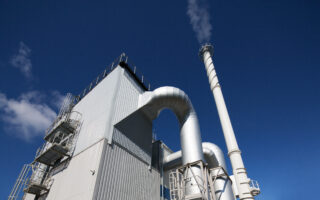Braun Intertec has recently been assisting wastewater treatment facilities with permitting to become Centralized Waste Treatment (CWT) facilities. A CWT wastewater discharge permit authorizes facilities under the Clean Water Act (CWA) to accept certain wastes from third-party off-site facilities for treatment and discharge. We wanted to provide more information on what exactly a CWT is, and how it differs from other widely used waste disposal facilities. The complexity of the CWA discharges and regulations versus the Resource Conservation and Recovery Act (RCRA) regulated waste management practices is fascinating and we will touch on some of the major differences.
CWT facilities are subject to the United States Environmental Protection Agency (US EPA) categorical effluent limitations guidelines (specifically those found in 40 CFR Part 437) that regulate the direct discharge of pollutants to surface waters and indirect discharge to publicly owned treatment works (POTWs). CWTs are facilities that treat, for disposal, recycling or recovery of material, hazardous and non-hazardous industrial wastes received from a variety of off-site sources. CWA-permitted CWTs can also accept certain wastes from off-site sources that are potentially regulated themselves by other effluent limitations or other regulatory programs governing air emissions, such as NESHAPs (for example refinery waste streams). The permit writer has the discretion to include additional effluent limitations for acceptance of specific waste streams, or they can incorporate the EPA CWT categorical effluent limitations directly into the permit. The CWT categorical effluent limitations cover treatment and discharge of oily waste streams, organic waste streams, metal-bearing waste streams, or a combination of all three. Therefore, a CWT can accept a wide range of industrial waste streams if the facility can effectively treat or recover materials from those waste streams and still meet the categorical effluent limitations. This simplifies and streamlines the permitting process and gives the CWT facility tremendous flexibility in its operations.
Before the development of the EPA CWT effluent limitations, many of these facilities still accepted third-party waste, but did so under agreements with state regulators written directly into their CWA discharge permits. States have tried to phase out that process and instead make broader use of the flexibility afforded by the EPA CWT effluent limitations.
The EPA RCRA manifest rules contained in 40 CFR Part 262.20(b) require that hazardous waste generators ensure their wastes are sent to a designated facility (i.e., authorized to accept such wastes). In an EPA letter to the Louisiana Department of Environmental Quality, EPA clarified that wastewater treatment units (WWTUs) that met the RCRA requirements for the RCRA wastewater exemption would be considered designated facilities for the purpose of receiving hazardous waste from off-site third-party generators. Both the generator and the transporter would be required to adhere to the rule requirements for manifesting their hazardous wastes properly and be sent off-site for treatment, storage or disposal. The three conditions qualifying a wastewater for the RCRA exemption are that the WWTU be considered a tank; be part of a wastewater treatment facility permitted under the CWA; and which receives, treats or stores an influent wastewater that is a hazardous waste.
The CWT regulations include a fairly robust system of waste management requirements, with many of the classic tenets of the RCRA programs. In a CWT CWA permit, profiling, classification, analytical, and treatability requirements are written conditions for the facility to be able to receive wastes. The specific permit requirements are based on the type of waste streams received (oily, organic and/or metal-bearing), and the effluent limitations promulgated for those waste streams. The profiling and treatability demonstrations for acceptance of waste streams become an important and integral part of the successful operation of the CWT. This is important to both the CWT facility and the clients sending their wastes to be treated and discharged through the CWT facility.
Many folks assume that all facilities that accept hazardous wastes are regulated under RCRA as Treatment, Storage, and Disposal Facilities (TSDFs); however, TSDFs differ significantly in permitting, acceptance protocols, and reporting requirements than CWTs. The important differentiation is that CWTs can only treat wastes for discharge under a CWA permit, while TSDFs may treat wastes by a variety of other means. TDSFs can also store wastes and act as disposal sites.
The RCRA exemption for wastewater extends only to the discharge of treated wastewater, and does not include residuals, such as sludges, generated by the treatment process and incidentally stored in the WWTUs. To be covered under the CWA permit, the application must entail all the elements and units comprising the wastewater treatment facility for those units to be considered part of the CWT. The CWT permit also does not exempt or authorize the storage of wastewater prior to treatment, so wastewater must directly enter the CWT facility, continuously flow through the WWTUs, and be discharged without intermediate storage. Therefore, the critical compliment to operation of a CWT is for the facility to obtain authorization for its waste management activities that are regulated by RCRA, as opposed to the CWA permit. CWA permits in Texas are being written specifying that the CWT permit does not provide or prohibit authorization for a facility to accept off-site third-party wastes, but instead authorizes the treatment and discharge of those wastes. It is the responsibility of the permittee to determine if additional authorizations for waste acceptance and management are needed for a particular site.
The RCRA wastewater exemption requirements, combined with the specific EPA requirements for CWTs, are considered to provide an equivalent level of protection for the management, treatment and discharge of treated wastes. The CWT application and approval process for Texas facilities provided an in-depth understanding about the underlying regulatory framework that goes into CWT and RCRA waste management programs, and into the regulatory history behind why the EPA developed effluent limitations for this industry. It underscores the importance of good waste profiling, classification, analytical, and treatability studies for the waste acceptance facility, and the teaming that needs to occur with your waste treatment and disposal facility. It also illustrates the importance of knowing where your waste is being processed, the importance of how it is permitted and the requirements that go along with those permits.
Contact us if you want to know more about waste disposal, permitting, CWTs or other pertinent waste questions by filling out the form to the right of this page.



